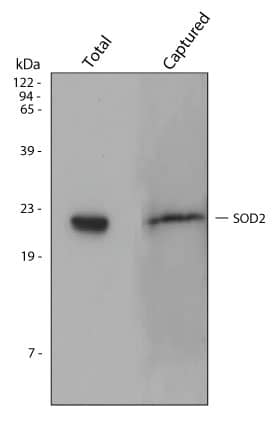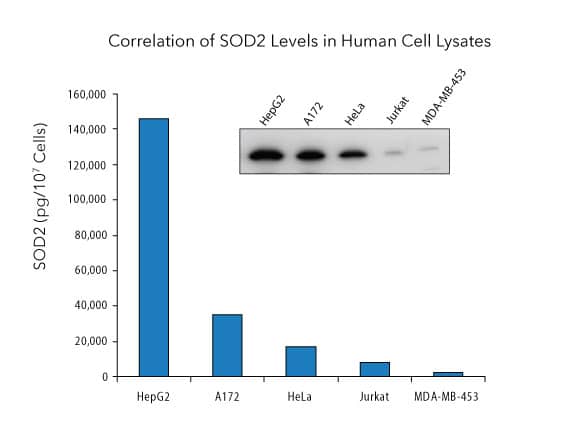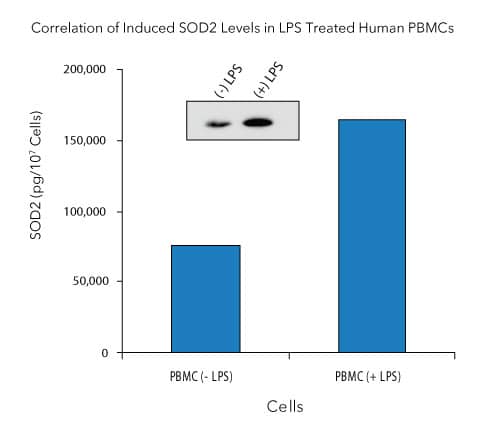Human/Mouse/RatTotal SOD2/Mn-SOD DuoSet IC ELISA
R&D Systems, part of Bio-Techne | Catalog # DYC3419-2

Key Product Details
Assay Type
Assay Range
Sample Type
Reactivity
Human/Mouse/RatTotal SOD2/Mn-SOD DuoSet IC ELISA Features
- Optimized capture and detection antibody pairings with recommended concentrations save lengthy development time
- Development protocols are provided to guide further assay optimization
- Assay can be customized to your specific needs
- Available in 2, 5, and 15- (96-well) plate pack sizes
- Economical alternative to Western blot
Product Summary for Human/Mouse/RatTotal SOD2/Mn-SOD DuoSet IC ELISA
This DuoSet IC ELISA contains the basic components required for the development of sandwich ELISAs to measure total SOD2 / Mn-SOD in cell lysates. An immobilized capture antibody specific for SOD2 / Mn-SOD binds both phosphorylated and unphosphorylated SOD2 / Mn-SOD. After washing away unbound material, a biotinylated detection antibody is used to detect both phosphorylated and unphosphorylated protein, utilizing a standard Streptavidin-HRP format.
Product Specifications
Assay Format
Sample Volume Required
Detection Method
Conjugate
Specificity
Label
Scientific Data Images for Human/Mouse/RatTotal SOD2/Mn-SOD DuoSet IC ELISA
Standard Curve
Detection of SOD2/Mn-SOD in HepG2 Cell Line Lysate.
Lysates prepared from HepG2 human hepatocellular carcinoma cells were incubated in wells coated with Human/Mouse/Rat Total SOD2/Mn-SOD Capture Antibody. Unbound material was removed by washing and bound material was solubilized in SDS gel sample buffer. The same lysate and captured protein were electrophoresed, transferred to a PVDF membrane, and immunoblotted with a Human/Mouse/Rat SOD2 Polyclonal Antibody (R&D Systems®, Catalog # AF3419). Only the band corresponding to SOD2 was detected in captured material. To further determine specificity, recombinant human SOD1 and recombinant human SOD3 were assayed at 200 ng/mL and did not cross-react or interfere in the assay.Detection of SOD2/Mn-SOD in Cancer Cell Lysate.
Lysates prepared from HepG2 human hepatocellular carcinoma cells, A172 human glioblastoma cells, HeLa human cervical epithelial carcinoma cells, Jurkat human acute T cell leukemia cells, and MDA-MB-453 human breast cancer cells were quantified with this DuoSet® IC ELISA. The same lysates were immunoblotted (inset) with an anti-SOD2 polyclonal antibody. The DuoSet® IC ELISA results correlate well with the relative amounts of human/mouse/rat SOD2 detected by Western Blot.Kit Contents for Human/Mouse/RatTotal SOD2/Mn-SOD DuoSet IC ELISA
- Capture Antibody
- Conjugated Detection Antibody
- Calibrated Immunoassay Standard or Control
- Streptavidin-HRP
Other Reagents Required
PBS: (Catalog # DY006), or 137 mM NaCl, 2.7 mM KCl, 8.1 mM Na2HPO4, 1.5 mM KH2O4, pH 7.2 - 7.4, 0.2 µm filtered
Wash Buffer: (Catalog # WA126), or equivalent
Lysis Buffer*
IC Diluent*
Blocking Buffer*
Substrate Solution: 1:1 mixture of Color Reagent A (H2O2) and Color Reagent B (Tetramethylbenzidine) (Catalog # DY999)
Stop Solution: 2 N H2SO4 (Catalog # DY994)
Microplates: From Costar EIA Plate (Costar Catalog # 2592) or R&D Systems (Catalog # DY990), or equivalent
Plate Sealers: ELISA Plate Sealers (Catalog # DY992), or equivalent
*For the Lysis Buffer, IC Diluent, and Blocking BUffer recommended for a specific DuoSet ELISA Development Kit, please see the product
Preparation and Storage
Shipping
Stability & Storage
Background: SOD2/Mn-SOD
Superoxide Dismutases, originally identified as Indophenoloxidases (IPOs), are enzymes that catalyze the conversion of naturally-occuring but harmful superoxide radicals into molecular oxygen and hydrogen peroxide. Three mammalian isozymes of SOD have been identified and are functionally related but have very modest sequence homology. SODs are typically soluble secreted or cytosolic proteins, but are also found in the mitochondria and extracellular matrix.
Any of three metals, manganese, iron, or copper, may be used in the active site of SOD and are indicative of cellular localization.MnSOD (SOD2) is found in the mitochondria of both prokaryotes and ukaryotes, whereas the cytosol of eukaryotes and prokaryotic organisms contains Cu/ZnSOD (SOD1) and FeSOD, respectively.
There have been several mutations identified in the Cu/ZnSOD (SOD1) gene in amyotrophic lateral sclerosis (ALS) patients, possibly suggesting a role for free radicals in this disease process. The mechanism of motor neuron degeneration that occurs in ALS, however, is unclear at this time. Several hypotheses have been explored for the role of mutant SOD1 and convincing evidence for the involvement of apoptosis has been presented, as well.
Long Name
Alternate Names
Gene Symbol
Additional SOD2/Mn-SOD Products
Product Documents for Human/Mouse/RatTotal SOD2/Mn-SOD DuoSet IC ELISA
Product Specific Notices for Human/Mouse/RatTotal SOD2/Mn-SOD DuoSet IC ELISA
For research use only




